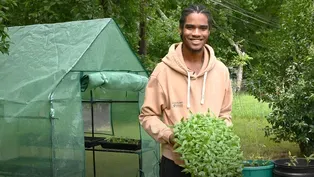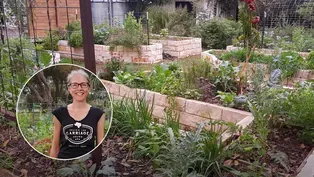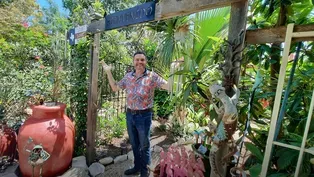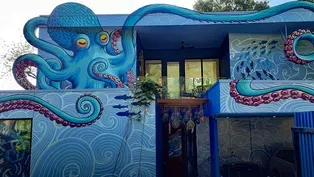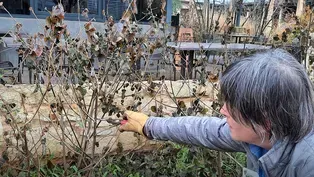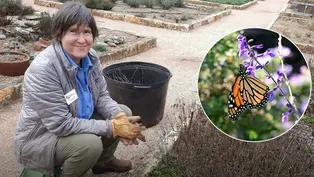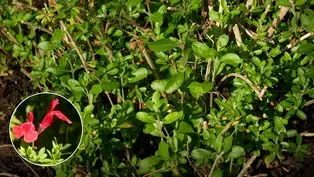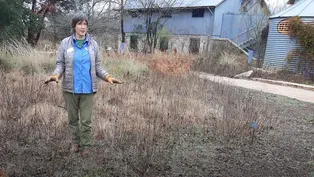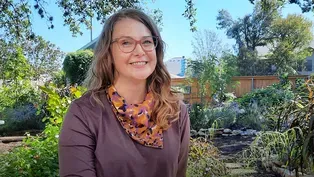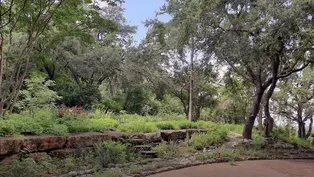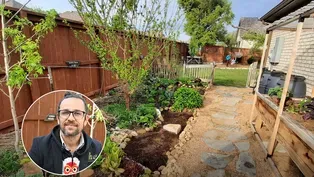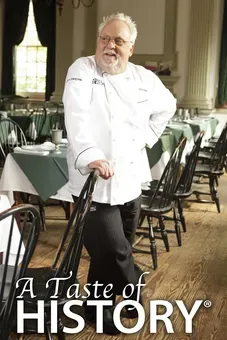
Side Yard Garden Permaculture Design
Clip: Season 28 | 8m 1sVideo has Closed Captions
A narrow side yard supports food and flowers with permaculture techniques.
What to do with that narrow strip between your house and the neighbor’s? With sustainable, permaculture techniques, Tyaga Welch put it to good use growing fruit trees, vegetables, herbs, and flowers for pollinators. He controls flooding by slowing and spreading rainfall to infiltrate soil. To maximize crops, narrow wicking and aquaponics beds grow healthy food with minimal resources.
Problems with Closed Captions? Closed Captioning Feedback
Problems with Closed Captions? Closed Captioning Feedback
Central Texas Gardener is a local public television program presented by Austin PBS
Support for CTG is provided by: Lisa & Desi Rhoden, and Diane Land & Steve Adler. Central Texas Gardener is produced by Austin PBS, KLRU-TV and distributed by NETA.

Side Yard Garden Permaculture Design
Clip: Season 28 | 8m 1sVideo has Closed Captions
What to do with that narrow strip between your house and the neighbor’s? With sustainable, permaculture techniques, Tyaga Welch put it to good use growing fruit trees, vegetables, herbs, and flowers for pollinators. He controls flooding by slowing and spreading rainfall to infiltrate soil. To maximize crops, narrow wicking and aquaponics beds grow healthy food with minimal resources.
Problems with Closed Captions? Closed Captioning Feedback
How to Watch Central Texas Gardener
Central Texas Gardener is available to stream on pbs.org and the free PBS App, available on iPhone, Apple TV, Android TV, Android smartphones, Amazon Fire TV, Amazon Fire Tablet, Roku, Samsung Smart TV, and Vizio.
Providing Support for PBS.org
Learn Moreabout PBS online sponsorship- What we're in right now, believe it or not, is a garden that hasn't even gone through a complete season cycle.
My name is Tyaga, Tyaga Welch, our company is Sustainable Humane Earth.
We also have another product company called Texas Turmeric, and we're permaculture designers, and permaculture is also inherently spiritual.
So we look at S.H.E.
Sustainable Humane Earth, as Mother Earth.
The garden was installed last summer, it was a completely blank space.
It's my parents' garden.
They didn't want to use the full backyard 'cause there's a big dog at the house, so they sectioned off a little side portion of the garden to use.
You can use any sort of space to your advantage, whether small or large.
Rather than digging up the grass, we'll just put a layer of cardboard and mulch and sometimes manure on top of that grass, depending on what kind of garden you wanna build.
So everything underneath our feet is all cardboard and mulch, and then we built the garden on top of that.
And so, what that does is it not only snuffs out the grass and the weeds, but also that cardboard and mulch activates microbiology and the earthworms and they start coming up to eat the mulch and the cardboard.
Not only that, we're using, what they call in permaculture, a dynamic accumulator, things like comfrey and borage that also are medicinal plants, also are pollinators.
But when you cut them and do a chop and drop, that adds as mulch and stuff too.
The pathway is made out of, again, it's sheet mulch underneath, so already it's a permeable pathway, but then we put a granite rock layer on top.
And then we use Oklahoma Silverstone as the large stepping stones because we have several elders that come through the garden, so we wanted it to be a nice walking, firm walking place, stable walking place as well.
In permaculture, you don't just have to catch rainwater in a rain cistern, you can also catch it in the ground itself.
So here in this garden, before we installed the rain barrels, we just used the rain gutter along the side of the house, put it underneath the pathway, and the rainwater now leeches into a rain garden.
And these are bioswales and the rainwater garden bioswale will fill up with water and the overflow point is a rock wall gabion, the rock wall gabion will overflow into the next swale, and subsequently continue to overflow down the garden.
What happens is we slow catch and spread all the water as it flows and moves down the property.
So we're watering less, which is good for the water bill and good for our water resources.
But it also is catching and holding debris, making all kinds of different little micro ecosystems down here, all the little rock edge, we use edge in permaculture, all along the little rock edge is perfect habitat for frogs and lizards and other predatory creatures that would eat the pests that would damage your plants as well.
So it's not just catching water, it's also creating a micro ecosystem.
'cause anywhere water is flowing, life will exist in its space.
We are mixing, not only perennial flowers, but annual flowers, like marigolds and sunflowers, because in permaculture, you're looking at the garden, I'm sure you've heard the term "food forest", but in permaculture, we look at the garden like a guild and that can be a micro guild and the entire garden itself can be a guild.
So it's not just the flowers, it's all the plant choices harmoniously growing together, cross pollinating and creating a ecosystem within every tiny little pocket, there's tiny little micro ecosystems.
Wicking beds grow soil and they save water.
You have a rock reservoir underneath the soil, the water's pumped under the rock reservoir and the soil mix is mixed in such a way where it absorbs and wicks the water from below.
So because of that, you can plant very densely and the roots don't have root competition.
Now you have a plant that's grown twice the size with less water and no pests.
You could even leave it for the weekend if you wanted to go away, you know, basically that pipe that runs underneath the soil is perforated and you could use any kind of perforated pipe.
I just water in the pipe itself that's sticking out of the top of the bed and you just look down the pipe to see the water level.
The pipe goes all the way down to the bottom.
If you have a 12 inch bed, most plants are taking most of their nutrients from the top six inches of the soil anyway.
So I use the bottom layer of the bed to cover the pipe with rocks, and that rock reservoir is where all the water is sitting.
The aquaponics system, whether it has fish in it or tadpoles or snails, whatever's in there producing nitrogen, all of that's pumped out on a solar pump.
And then it goes into the media bed and that's where the real magic happens, the media bed's full of red wiggler worms and they take up all the nitrogen and extra debris that might fall into the media.
They eat and digest that, and we know that soil is only soil when it's gone through the gut of a worm.
So really it's the worms working the magic and transferring the nitrogen into a soluble nutrient for the plant roots.
And so, the plant root, the media and the plant roots also take up nutrients and filter the water further for the fish or whatever creatures might be living in the pond.
Turmeric found us, I did not find turmeric.
I discovered it in a compost pile, which that also tells you that your compost is not composting if it's growing live plants in it, so that was a good teaching tool as well.
After years and years of research and studying and working with it ourselves, we figured out that it works really good in aquaponics media beds, and I started growing it there, not exclusively, we grow it in the wicking beds, I grow it in the ground, I grow it in pots.
Because I'm limited on space and I produce turmeric as a product, I have to find all kinds of different alternative ways to grow it.
Because of these really extreme storms and extreme weather we've been having, both in winter and summer, over all of my aquaponics or wicking beds, I always build a little miniature greenhouse structure.
And my father built this one and he used mostly either found or reused, repurposed, upcycled materials to do it, including the panels that cover the top.
And then we built a wood frame around it so that if we got those really intense snows, everything would hold up.
Our two front beds are like the handshake of the garden.
Also, what I really love about it is that because now the plants are beautiful and growing, you would never know what's underneath the soil.
And underneath the soil, we dug down a little bit into the ground and buried a bunch of branches and logs and made a hugelkultur underneath the soil.
We made the soil mix heavy on wood mulch that could absorb and hold moisture as well.
Then, around the edge of the garden, we lined it with what's called a rock wall gabion, which will hold any debris and water from leaving the site.
So we're growing soil in those gardens, we're protecting it from evaporation and because of those two things, we're doing a lot less work 'cause the plants are able to maintain that little section without hardly any maintenance.
So in permaculture, when you hear the term "food forest", a lot of folks think that it has to be a large, elaborate rural forest.
Well, you can make a micro forest or a micro guild in a very small, tiny, little urban space.
What we're doing, it's almost like using biomimicry.
You're looking at the forest as a whole and then mimicking that in the garden.
The forest never grows in monoculture, it's always a diverse network of species, growing together harmoniously to protect each other.
So that is quite literally how we even view a small, tiny little potter, a planter garden can be a micro permaculture guild.
The best way to learn is to just get on with it.
If you just get your own hands working in the soil and digging in the soil, you'll learn the most just from doing.
Growing Community: Body and Soul
Video has Closed Captions
Lenny West found his anchor and mission in providing fresh vegetables to food desert neighbors. (6m 18s)
Native Plant Garden in HOA: Martin Byhower
Video has Closed Captions
A California-to-Texas environmentalist helps neighbors garden for wildlife in extreme weather. (8m 42s)
Permaculture Design: Raised Beds and Food Forest
Video has Closed Captions
Limestone raised beds and a mandala-designed food forest honor resourceful permaculture tenets. (9m 15s)
Creating Moods in a Regular Backyard
Video has Closed Captions
Imagination, creative reuse, and spirited fun turned a backyard into a sensory voyage. (7m 41s)
Video has Closed Captions
New gardener Nancy Hall relied on plants–adapted and native–to teach her their ways. (7m 49s)
Artistic Collaboration Goes with the Flow
Video has Closed Captions
When rainwater runoff plagued a family’s home, they plunged into a whimsical makeover. (8m 25s)
Winter Pruning: Wax Mallow for Spring’s Spiderworts
Video has Closed Captions
See how to cut back wax mallow (turk’s cap) to show off spring-blooming spiderworts. (3m 25s)
Winter Pruning: Mealy Blue Sage
Video has Closed Captions
See where to cut back old stalks on perennial mealy blue sage. (3m 16s)
Video has Closed Captions
Learn how to prune this evergreen woody shrub/subshrub. (4m 47s)
Video has Closed Captions
See why to progressively prune grasses and herbaceous perennials. (1m 35s)
Garden Makeover Grows New Friends and Career
Video has Closed Captions
Jennie Ostertag broke a few shovels changing her yard and life’s path. (9m 18s)
Video has Closed Captions
James Truchard created diverse habitats to offset a future of climate changes. (8m 49s)
Drought Design: Change of Plans & Plants
Video has Closed Captions
Mistakes led new gardeners back to the drawing board with native plants. (8m 55s)
Side Yard Garden Permaculture Design
Video has Closed Captions
A narrow side yard supports food and flowers with permaculture techniques. (8m 1s)
Front Yard Native Plant Wildlife Habitat
Video has Closed Captions
Removing lawn for native plants brings pollinators to a young couple’s front yard. (9m 35s)
Providing Support for PBS.org
Learn Moreabout PBS online sponsorshipSupport for PBS provided by:
Central Texas Gardener is a local public television program presented by Austin PBS
Support for CTG is provided by: Lisa & Desi Rhoden, and Diane Land & Steve Adler. Central Texas Gardener is produced by Austin PBS, KLRU-TV and distributed by NETA.
